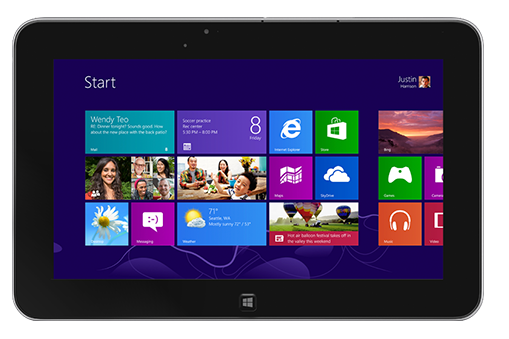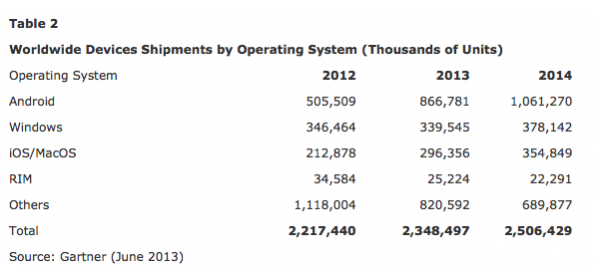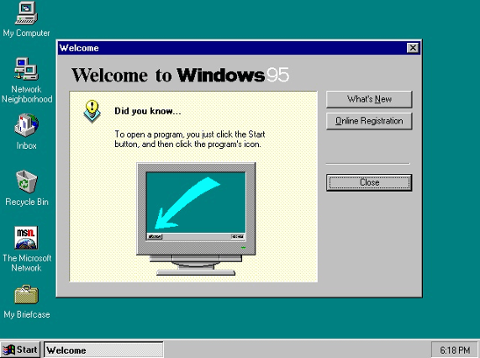[caption id="attachment_10614" align="aligncenter" width="509"]

Windows 8.[/caption] This week, Microsoft will
use its BUILD conference in San Francisco to show off Windows 8.1, the first major update of its latest operating system. Many details of Windows 8.1 (codenamed “Windows Blue”) are already in the open: in addition to reintroducing the Start button, which was deleted from the original Windows 8, the update will include a boot-to-desktop option, allowing users to skip over the tile-filled Start screen. That screen was meant to make Windows 8 a viable operating system for tablets in addition to “traditional” PCs, by allowing users to tap on the tiles to access applications; those who wanted the desktop interface could only do so by tapping (or clicking, in the case of devices limited to mouse-and-keyboard input) on a specific tile. But a number of users complained stridently about the Start screen, and Microsoft has evidently heard those complaints. The question now is what features—if any—Microsoft is holding in reserve for a BUILD rollout. Microsoft will use BUILD to make Windows 8’s case to developers and businesses. With 1.81 percent of the market (according to analytics firm
Net Applications), the operating system has a long way to go before it can challenge Windows 7 (at 42.97 percent) much less the aging Windows XP (42.24 percent). When Windows 7 came out at the end of 2009, it benefitted from a high degree of pent-up demand: Windows XP was already old, Windows Vista had never taken off, and companies wanted a new operating system to go with their hardware refreshes. Windows 8 couldn’t benefit from any of that, and faces the additional pressure of a somewhat-new user interface. Research firm Gartner has recommendations for businesses considering whether to upgrade to Windows 8.1. “If you have been avoiding Windows 8.0 but usually prefer to adopt a new OS via PC refresh,” two of the organization’s analysts, Michael Silver and Stephen Kleynhans,
wrote in a May research note, “consider deploying Windows 8.1 on newly purchased PCs after you have completed the requisite testing—especially with IE 11.” For those organizations engaged in the early planning phases of Windows 8 deployments, they added, “pilot on Windows 8 if it makes sense, but switch to the Windows 8.1 beta as soon as possible.” Even if more businesses adopt Windows 8, however, it might not help Microsoft in the long run. Gartner recently looked at operating-system market share from the perspective of all devices—dumping tablets, smartphones and PCs into the same bucket—and found that Google Android not only leads Windows, but that its lead is steadily increasing:

When all devices and operating systems are factored in, Apple becomes a much stronger Windows competitor, nearly catching up to Microsoft. “Although the numbers seem to paint a clear picture of who the winner will be when it comes to operating systems (OS) in the device market (see Table 2), the reality is that today ecosystem owners are challenged in having the same relevance in all segments,” Carolina Milanesi, research vice president at Gartner, wrote in a statement attached to the data. “Apple is currently the more homogeneous presence across all device segments, while 90 percent of Android sales are currently in the mobile phone market and 85 percent of Microsoft sales are in the PC market.” In other words, Microsoft may have designed Windows 8 to give it a far larger slice of the mobile-device market—but expanding the software onto a variety of form-factors also opens it up to competition (and direct comparisons) with Android and iOS. Microsoft will doubtlessly use BUILD to highlight what it terms Windows 8’s “momentum” (and draw attention to its other products and platforms), but the hardest part of the company’s battle is only just beginning.
Images: Microsoft, Gartner  Windows 8.[/caption] This week, Microsoft will use its BUILD conference in San Francisco to show off Windows 8.1, the first major update of its latest operating system. Many details of Windows 8.1 (codenamed “Windows Blue”) are already in the open: in addition to reintroducing the Start button, which was deleted from the original Windows 8, the update will include a boot-to-desktop option, allowing users to skip over the tile-filled Start screen. That screen was meant to make Windows 8 a viable operating system for tablets in addition to “traditional” PCs, by allowing users to tap on the tiles to access applications; those who wanted the desktop interface could only do so by tapping (or clicking, in the case of devices limited to mouse-and-keyboard input) on a specific tile. But a number of users complained stridently about the Start screen, and Microsoft has evidently heard those complaints. The question now is what features—if any—Microsoft is holding in reserve for a BUILD rollout. Microsoft will use BUILD to make Windows 8’s case to developers and businesses. With 1.81 percent of the market (according to analytics firm Net Applications), the operating system has a long way to go before it can challenge Windows 7 (at 42.97 percent) much less the aging Windows XP (42.24 percent). When Windows 7 came out at the end of 2009, it benefitted from a high degree of pent-up demand: Windows XP was already old, Windows Vista had never taken off, and companies wanted a new operating system to go with their hardware refreshes. Windows 8 couldn’t benefit from any of that, and faces the additional pressure of a somewhat-new user interface. Research firm Gartner has recommendations for businesses considering whether to upgrade to Windows 8.1. “If you have been avoiding Windows 8.0 but usually prefer to adopt a new OS via PC refresh,” two of the organization’s analysts, Michael Silver and Stephen Kleynhans, wrote in a May research note, “consider deploying Windows 8.1 on newly purchased PCs after you have completed the requisite testing—especially with IE 11.” For those organizations engaged in the early planning phases of Windows 8 deployments, they added, “pilot on Windows 8 if it makes sense, but switch to the Windows 8.1 beta as soon as possible.” Even if more businesses adopt Windows 8, however, it might not help Microsoft in the long run. Gartner recently looked at operating-system market share from the perspective of all devices—dumping tablets, smartphones and PCs into the same bucket—and found that Google Android not only leads Windows, but that its lead is steadily increasing:
Windows 8.[/caption] This week, Microsoft will use its BUILD conference in San Francisco to show off Windows 8.1, the first major update of its latest operating system. Many details of Windows 8.1 (codenamed “Windows Blue”) are already in the open: in addition to reintroducing the Start button, which was deleted from the original Windows 8, the update will include a boot-to-desktop option, allowing users to skip over the tile-filled Start screen. That screen was meant to make Windows 8 a viable operating system for tablets in addition to “traditional” PCs, by allowing users to tap on the tiles to access applications; those who wanted the desktop interface could only do so by tapping (or clicking, in the case of devices limited to mouse-and-keyboard input) on a specific tile. But a number of users complained stridently about the Start screen, and Microsoft has evidently heard those complaints. The question now is what features—if any—Microsoft is holding in reserve for a BUILD rollout. Microsoft will use BUILD to make Windows 8’s case to developers and businesses. With 1.81 percent of the market (according to analytics firm Net Applications), the operating system has a long way to go before it can challenge Windows 7 (at 42.97 percent) much less the aging Windows XP (42.24 percent). When Windows 7 came out at the end of 2009, it benefitted from a high degree of pent-up demand: Windows XP was already old, Windows Vista had never taken off, and companies wanted a new operating system to go with their hardware refreshes. Windows 8 couldn’t benefit from any of that, and faces the additional pressure of a somewhat-new user interface. Research firm Gartner has recommendations for businesses considering whether to upgrade to Windows 8.1. “If you have been avoiding Windows 8.0 but usually prefer to adopt a new OS via PC refresh,” two of the organization’s analysts, Michael Silver and Stephen Kleynhans, wrote in a May research note, “consider deploying Windows 8.1 on newly purchased PCs after you have completed the requisite testing—especially with IE 11.” For those organizations engaged in the early planning phases of Windows 8 deployments, they added, “pilot on Windows 8 if it makes sense, but switch to the Windows 8.1 beta as soon as possible.” Even if more businesses adopt Windows 8, however, it might not help Microsoft in the long run. Gartner recently looked at operating-system market share from the perspective of all devices—dumping tablets, smartphones and PCs into the same bucket—and found that Google Android not only leads Windows, but that its lead is steadily increasing:  When all devices and operating systems are factored in, Apple becomes a much stronger Windows competitor, nearly catching up to Microsoft. “Although the numbers seem to paint a clear picture of who the winner will be when it comes to operating systems (OS) in the device market (see Table 2), the reality is that today ecosystem owners are challenged in having the same relevance in all segments,” Carolina Milanesi, research vice president at Gartner, wrote in a statement attached to the data. “Apple is currently the more homogeneous presence across all device segments, while 90 percent of Android sales are currently in the mobile phone market and 85 percent of Microsoft sales are in the PC market.” In other words, Microsoft may have designed Windows 8 to give it a far larger slice of the mobile-device market—but expanding the software onto a variety of form-factors also opens it up to competition (and direct comparisons) with Android and iOS. Microsoft will doubtlessly use BUILD to highlight what it terms Windows 8’s “momentum” (and draw attention to its other products and platforms), but the hardest part of the company’s battle is only just beginning. Images: Microsoft, Gartner
When all devices and operating systems are factored in, Apple becomes a much stronger Windows competitor, nearly catching up to Microsoft. “Although the numbers seem to paint a clear picture of who the winner will be when it comes to operating systems (OS) in the device market (see Table 2), the reality is that today ecosystem owners are challenged in having the same relevance in all segments,” Carolina Milanesi, research vice president at Gartner, wrote in a statement attached to the data. “Apple is currently the more homogeneous presence across all device segments, while 90 percent of Android sales are currently in the mobile phone market and 85 percent of Microsoft sales are in the PC market.” In other words, Microsoft may have designed Windows 8 to give it a far larger slice of the mobile-device market—but expanding the software onto a variety of form-factors also opens it up to competition (and direct comparisons) with Android and iOS. Microsoft will doubtlessly use BUILD to highlight what it terms Windows 8’s “momentum” (and draw attention to its other products and platforms), but the hardest part of the company’s battle is only just beginning. Images: Microsoft, Gartner 